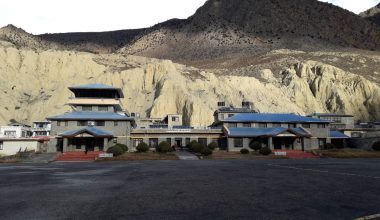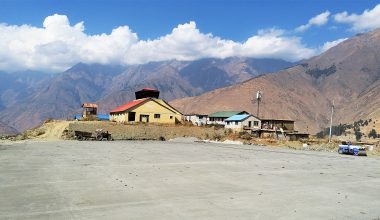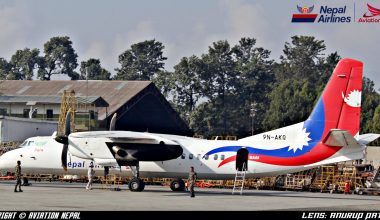Dornier 328 is a German-built turboprop-powered airliner competing in a 30-seat regional market. Designed for short-haul passenger operations, the commuter aircraft can operate from rough and semi-prepared runways. The versatile aircraft is adaptable to various environmental conditions, from the hot Arabic desert to the extreme colds of the Himalayas. The iconic 328 Dornier aircraft first took off to the skies on 6 December 1991 and entered revenue service in October 1993.
Initially started by Dornier Luftfahrt GmbH, the 328 program was acquired by American manufacturer Fairchild Aircraft in the late 1990s. The US Company bought most of Dornier’s civil assets in June 1996 and commenced Dornier 328 production in 1998 as ‘Fairchild-Dornier.’

217 Dornier 328 units were built during a nine-year production run from 1991 to 2000. Fairchild Dornier suffered substantial financial difficulties at the turn of the century and became bankrupt in April 2002. Although the 328 Dornier entered the history book in 2000, few examples are still in active service. A handful of 328 Dornier airliners still grace the skies, with primary users being Central Mountain Air, Rhein-Neckar Air, etc.
Development of Dornier 328
The Dornier 328 program originated in 1984 when market research indicated airlines needed a fast and quiet regional aircraft. The German manufacturer Dornier launched the 328 project in December 1988 and operated the maiden flight of the Dornier 328 turboprop two years later.
The turboprop engine-powered 328 entered commercial service on 13 October 1993. The delayed service entry coincided with intense competition within the regional airliner market. The aircraft entered the commercial service when many newly launched regional jets competed to grab a regional market share.
The new Dornier 328 commuter airliner had an edge over competing turboprops in terms of both noise levels and speed. However, this was not enough to improve the commercial/sales performance of the Dornier 328 turboprop. The recession occurred during the latter half of the 328 program, and airlines found themselves mired in years-long slump. As a result, they curtailed demand for new aircraft, further hampered the Dornier 328’s sales. The below-targeted sales of Dornier 328 and its turbofan variant 328Jet pushed the manufacturer into a precarious financial position.

After nine years, the Dornier 328 turboprop production ended in 2000, with 217 units built. The financially distressed Dornier Fairchild Company collapsed in 2002, and M7 Aerospace acquired its assets.
Dornier 328 revival attempts
Following Fairchild Dornier’s collapse in 2002, AvCraft Aviation bought the 328 production line in February 2003. The Myrtle Beach-based company attempted to reinstate the Dornier 328 turboprop/jet production in 2004 but entered bankruptcy in March 2005.
In 2015, US engineering company Sierra Nevada Corp. (SNC) bought Germany-based 328 Support Services and signed an MOU with Turkish Ministry for 328 production. The plan was to produce Turkish 328 incarnations (designated T328 and TR328 for turboprop and jet versions resp.) under the nation’s Regional Aircraft Project at a new factory near Ankara.
However, in 2017, Turkey scrapped 328 revival plan to focus on its 100% home-built large commercial jet aircraft. In search of new avenues to revive the original Dornier 328, the 328SSG company formed DRA GmbH in August 2019. In collaboration with the German government and the state of Saxony, DRA GmbH intends to relaunch the turboprop 328. The revised version of the turboprop rebranded as ‘D328eco’ is targeted at an entry-into-service in 2025. The plan is to conduct the maiden flight of the new Dornier 328-based aircraft by 2023 or 2024 and deliver the first example by 2025.
Specification of 328 Dornier aircraft
The 328 Dornier aircraft is a leader in a 30-32 seat regional segment, thanks to its outstanding performance and versatility. Measuring 21.23 m long (69 feet, 8 inches), the standard Dornier 328-110 features an unusual streamline-shaped fuselage optimized for high cruising speeds. The commuter airliner can comfortably seat 30 people, while its maximum passenger capacity in a dense cabin configuration is 33. The legendary 328 can carry three crew (2 pilots and 1 flight attendant) and a payload of 4,890 kg (10,781lb).
Powered by two Pratt and Whitney PW119C turboprop engines, the 328 cruises at 620km/hr. The twin-turboprop engines work in tandem to enable the airliner to crisscross the skies for up to 1,852 km.

Dornier 328 is one of the quietest aircraft in its class due to the application of various noise-absorbent measures. The airliner is equipped with noise-absorbent material across the fuselage, while isolator brackets project from the cabin wall to lower vibration and noise transference. The low cabin noise level makes the passenger experience onboard 328 as relaxing and comfortable as possible.
328 cockpit
The German-built 328 regional turboprop has a twin-crew glass cockpit. The cockpit features a Honeywell Primus 2000 avionics suite composed of multiple display units to unveil all information crucial to flight. There are five 20 x 17.5 cm CRT monitors; the inner two are multifunctional displays, and the outermost two are primary flight displays. The central CRT, serving as EICAS, provides the flight crew with instrumentation and crew annunciations for various aircraft systems.
Other avionics installed in Dornier 328 include
- Primal 650 weather radar
- A dual-integrated avionics computer
- A digital databus
- GPWS (a ground proximity warning system)
- TCAS (a traffic collision avoidance system)
- Automatic flight control system
- Dual mode-S transponder, etc.
Dornier 328 operators
The versatile Dornier 328 is suitable for both military and civilian roles.
In the military domain, the aircraft serves the US and Botswana air forces. The US Air Force’s Special Operations Command flies 20 examples of 328 aircraft for cargo and personnel transport missions. The C-146A, the military variant of the 328, has been around since October 2011 and provides flexible, rapid, and intra-theater mobility for special operations forces. They clock in more than 25 years on average and can carry a maximum of 27 passengers and 6,000 pounds of cargo.

On the civilian front, the 328 airliner flies for a handful of companies operating in different countries. Notable operators include Private Wings (Germany), Central Mountain Air (Canada), Rhein-Neckar Air (Germany), Eagle Air (Iceland), etc.
The regional turboprop has historically served as a scheduled passenger aircraft for several US regional airlines. These operators include Horizon Air, Lone Star Airlines, PSA Airlines, Mountain Air Express, United Express, US Airways Express, etc.
Variants of 328 turboprop-powered commuter airliner
- 328-100: Early-built 328
- 328-110: Standard 328 aircraft characterized by greater fuel range and weight
- 328-120: 328 airliner with refined Short Takeoff and Landing (STOL) capabilities
- 328-130: 328 airliner with improved short-field performance and progressive rudder authority reduction at soaring airspeeds
- 328JET: The turboprop-powered Dornier 328
- C-146A Wolfhound: The twin-engine, high-wing military aircraft operated by USAF’s Special Operations Command for cargo and personnel transport mission
Dornier 328JET: The turbofan-powered counterpart
Dornier 328 JET is a turbofan-powered counterpart of the original 328 turboprops produced in the late 1990s. Originally known as 328-300, the 328JET was designed to appeal to those customers who previously reported a negative perception of reliability issues with the 328 Dornier turboprop. The 328 Jet was fitted with a pair of PW306 turbofan engines, enabling it to attain a maximum speed of 750km/hr. The incorporation of turbofan engines enhanced the Dornier 328’s range to 2,740km. With increased range, the new turbofan-based variant presented growth opportunities for regional carriers in important markets.
Although the new 328Jet was excellent performance-wise, it failed to gain commercial success. After manufacturing just 110 examples, ailing Fairchild-Dornier pulled the plug on the 328Jet production in 2002. The company failed to achieve profitability on the 328JET and was in a difficult financial position. The undercapitalized company was rendered insolvent the same year.

Do 328 Frequently Asked Questions
- Which country made 328?
German aircraft manufacturer Dornier Luftfahrt GmbH launched the 328 in December 1988. The Friedrichshafen-based private company was acquired by US-based Fairchild in 1996, resulting in the creation of the Fairchild Dornier Company. The manufacturing of the 328 family took place at the company’s facility in Oberpfaffenhofen, Germany. However, the company conducted sales from its US headquarter in San Antonio, Texas.
- How many 328s were made?
Only 217 examples of 328 were built throughout a nine-year production cycle. Despite being the premier turboprop, the aircraft didn’t sell well. Delayed introduction, fierce competition, and curtailed aircraft demand due to the recession affected the sales of the Dornier 328 turboprop.
- What is the maximum range of the 328?
The twin-turboprop engined, short-range 328 has a maximum fuel range of 1,852km (1,151 mi, 1000nmi). The aircraft is ideal for short-haul missions and can land and take off from anywhere, even from underprepared airstrips.






